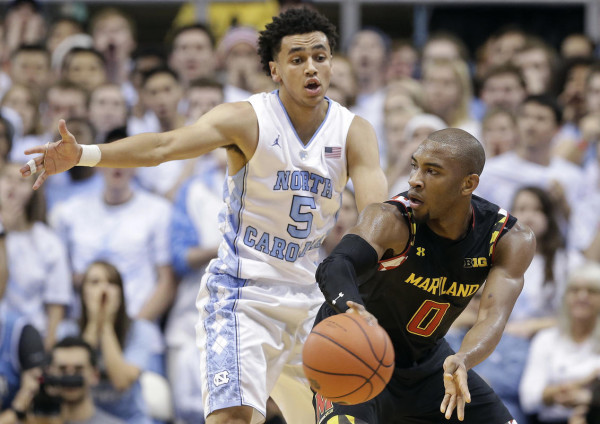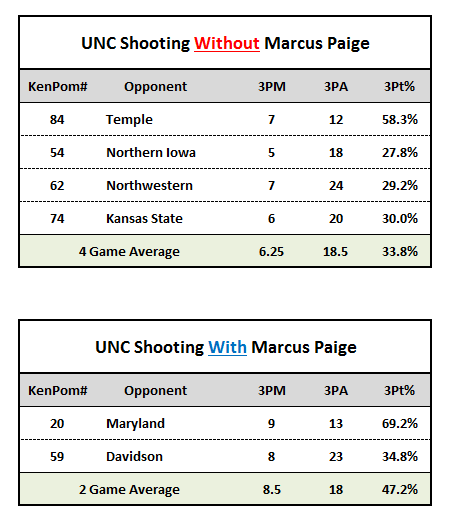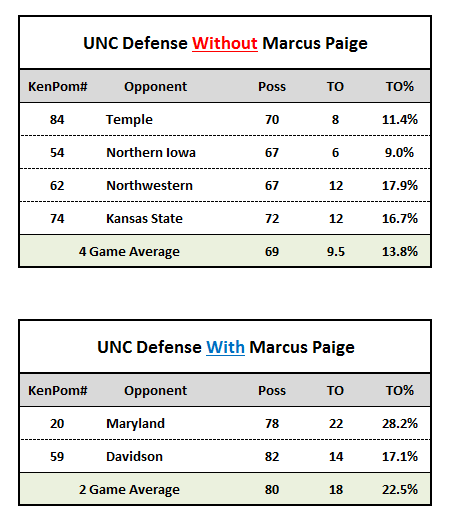North Carolina Looks Complete With Marcus Paige Back
Posted by Brad Jenkins (@bradjenk) on December 8th, 2015Coming into this season, North Carolina was considered one of the best bets to make it to Houston for the Final Four. Those expectations for Roy Williams’ squad were in large part due to the return of senior guard Marcus Paige. Unfortunately, Paige suffered a broken hand before the season began and the Tar Heels dropped an early game against Northern Iowa in his absence. But Paige made an impressive return to the lineup last week in convincing wins over Maryland and Davidson, helping North Carolina look like the team that many expect to challenge for a spot in the season’s final weekend.

As expected, Marcus Paige has helped North Carolina’s perimeter on both ends of the floor. (AP Photo/Gerry Broome)
Although North Carolina performed reasonably well without Paige, the Heels are clearly a better team with their senior leader back on the court. A solid two-way player throughout his career, Paige has already had a positive impact on both ends of the floor. Joel Berry, Theo Pinson and Nate Britt admirably filled in as long-range threats without Paige in the lineup for the team’s first four games against top-100 competition, but eventually that trio cooled from three-point range (see below table). In the two games since his return, Paige has directly contributed (6-of-10 on threes) to UNC’s improved shooting, but he has also helped his teammates get better looks. The rest of the team has made 42.3 percent of its long-range attempts since he returned, for a total of 47.2 percent.
As much as Paige has helped the Tar Heels’ offense, he could be having a greater impact on its perimeter defense. The team’s defense has been far more successful in forcing turnovers since Paige’s return, and it’s no coincidence that its only loss of the year came when Northern Iowa gave the ball away six times against a Paige-less lineup. Maryland came into the Big Ten/ACC Challenge game in Chapel Hill committing only 12.1 turnovers per game, but the Tar Heels forced the Terrapins into 22 miscues, including 13 in the first half. Melo Trimble scored 23 points along with 12 assists, but he also suffered a career-high eight turnovers against the pressure. The 14 turnovers UNC forced against Davidson may be even more impressive when you consider that Bob McKillop’s team currently leads the nation in turnover percentage at 11.2 percent. Paige is of course not personally forcing all those mistakes, but his ability to pressure the ball and deny passing lanes is a big reason why North Carolina is causing opposing teams to struggle so much with their ball-handling.
Williams has always preferred to have an inside-oriented team, but his championship clubs have successfully balanced dominance in the paint with superior perimeter play. Paige gives that kind of leverage to this year’s squad, but he’s also getting more help than he has in years past. Sophomores Berry and Pinson are much improved in their second college seasons and have paired with Britt to provide solid backcourt support. Justin Jackson has emerged as one of the country’s best wings as a sophomore. He’s averaging 18.4 points per game in his last five outings while shooting a red-hot 55.6 percent from the field. Talented and experienced bigs like Kennedy Meeks, Brice Johnson and Isaiah Hicks will have the advantage over opponents in the paint on most nights. But with a now-healthy Paige running things, Williams has an equally dangerous backcourt at his disposal. We’ll find out a bit more about the Tar Heels’ ability to maintain consistency (a legitimate problem with last year’s squad) when they travel to play Texas in Austin on Saturday.












































